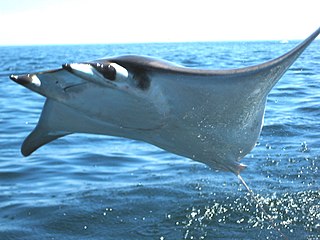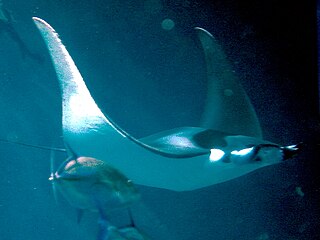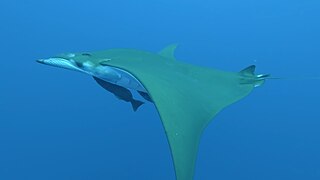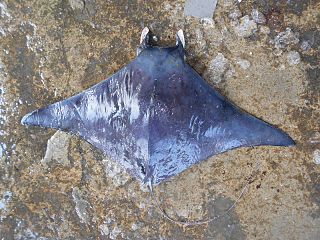
Manta rays are large rays belonging to the genus Mobula. The larger species, M. birostris, reaches 7 m (23 ft) in width, while the smaller, M. alfredi, reaches 5.5 m (18 ft). Both have triangular pectoral fins, horn-shaped cephalic fins and large, forward-facing mouths. They are classified among the Myliobatiformes and are placed in the family Myliobatidae. They have the largest brains and brain to body ratio of all fish, and can pass the mirror test.

Myliobatiformes is one of the four orders of batoids, cartilaginous fishes related to sharks. They were formerly included in the order Rajiformes, but more recent phylogenetic studies have shown the myliobatiforms to be a monophyletic group, and its more derived members evolved their highly flattened shapes independently of the skates.

The eagle rays are a group of cartilaginous fishes in the family Myliobatidae, consisting mostly of large species living in the open ocean rather than on the sea bottom.

The guitarfish, also referred to as shovelnose rays, are a family, Rhinobatidae, of rays. The guitarfish are known for an elongated body with a flattened head and trunk and small, ray-like wings. The combined range of the various species is tropical, subtropical, and warm temperate waters worldwide.

Mobula is a genus of rays in the family Mobulidae that is found worldwide in tropical and warm, temperate seas. Some authorities consider this to be a subfamily of the Myliobatidae. Their appearance is similar to that of manta rays, which are in the same family, and based on genetic and morphological evidence, the mantas belong in Mobula.

The devil fish or giant devil ray is a species of ray in the family Mobulidae. It is currently listed as endangered, mostly due to bycatch mortality in unrelated fisheries.

The spinetail devil ray, also known as the spinetail mobula ray or Japanese mobula ray, is a species of pelagic marine fish which belongs to the family Mobulidae. It is found throughout the tropical and sub-tropical waters of the Indo-Pacific and eastern Atlantic Ocean.

Mobula munkiana, commonly known as the manta de monk, Munk's devil ray, pygmy devil ray, smoothtail mobula or Munk’s pygmy devil ray is a species of ray in the family Mobulidae. It is found in tropical parts of the eastern Pacific Ocean, ranging from the Gulf of California to Peru, as well as near offshore islands such as the Galapagos, Cocos, and Malpelo. Munk's devil ray was first described in 1987 by the Italian ecologist Giuseppe Notarbartolo di Sciara and named for his scientific mentor, Walter Munk.

The Chilean devil ray, also known as the box ray, greater Guinean mobula, sicklefin devil ray or the spiny mobula, is a species of ray in the family Mobulidae. It is often observed worldwide, basking just below the surface in tropical, subtropical and warm temperate oceans, mainly offshore, and occasionally appearing near the coast. It can reach a disc width of up to 3.7 m (12 ft).

The bentfin devil ray, also known as the lesser devil ray, smoothtail devil ray, smoothtail mobula or Thurston's devil ray, is a species of ray in the family Mobulidae. It is found worldwide in tropical, subtropical and warm temperate oceans, with records from Australia, Brazil, Chile, Costa Rica, Ecuador, Egypt, El Salvador, Eritrea, Guatemala, Honduras, India, Indonesia, Ivory Coast, Japan, Malaysia, Maldives, Mexico, Myanmar, Nicaragua, Oman, Pakistan, Peru, the Philippines, Saudi Arabia, Senegal, South Africa, Sri Lanka, Thailand, United Arab Emirates, United States (California), Uruguay, Vanuatu and throughout the central and western Pacific. It likely occurs in many other locations in tropical, subtropical and warm temperate oceans. It is found both offshore and near the coast.

Rhinobatos is a genus of fish in the Rhinobatidae family. Although previously used to encompass all guitarfishes, it was found to be polyphyletic, and recent authorities have transferred many species included in the genus to Acroteriobatus, Glaucostegus, and Pseudobatos.

Arhynchobatidae is a family of skates whose members are commonly known as the softnose skates. It belongs to the order Rajiformes in the superorder Batoidea of rays. At least 104 species have been described, in 13 genera. Softnose skates have at times been placed in the same family as hardnose skates, but most recent authors recognize them as a distinct family. Members of the Arhynchobatidae can be distinguished from hardnose skates in having a soft and flexible snout, as well as a more or less reduced rostrum.

The whiptail stingrays are a family, the Dasyatidae, of rays in the order Myliobatiformes. They are found worldwide in tropical to temperate marine waters, and a number of species have also penetrated into fresh water in Africa, Asia, and Australia. Members of this family have flattened pectoral fin discs that range from oval to diamond-like in shape. Their common name comes from their whip-like tails, which are much longer than the disc and lack dorsal and caudal fins. All whiptail stingrays, except the porcupine ray, have one or more venomous stings near the base of the tail, which is used in defense. In order to sting their victims, they jerk their tails as the stinger falls off and stays in the wound that they have created. The stinger of a whiptail stingray is pointy, sharp with jagged edges. They range in size from 0.18 to 2.0 m or more across in the case of the smalleye stingray and giant freshwater stingray.

Batoidea is a superorder of cartilaginous fishes, commonly known as rays. They and their close relatives, the sharks, comprise the subclass Elasmobranchii. Rays are the largest group of cartilaginous fishes, with well over 600 species in 26 families. Rays are distinguished by their flattened bodies, enlarged pectoral fins that are fused to the head, and gill slits that are placed on their ventral surfaces.

The giant oceanic manta ray, giant manta ray, or oceanic manta ray is a species of ray in the family Mobulidae, and the largest type of ray in the world. It is circumglobal and is typically found in tropical and subtropical waters, but can also be found in temperate waters. Until 2017, the species was classified in the genus Manta, along with the smaller reef manta ray. DNA testing revealed that both species are more closely related to rays of the genus Mobula than previously thought. As a result, the giant manta was renamed as Mobula birostris to reflect the new classification.

The reef manta ray is a species of ray in the family Mobulidae, one of the largest rays in the world. Among generally recognized species, it is the second-largest species of ray, only surpassed by the giant oceanic manta ray.

Mobula kuhlii, the shortfin devil ray, is a species of ray in the family Mobulidae. It is endemic to the Indian Ocean and central-west Pacific Ocean. It ranges from South Africa, Mozambique, Tanzania and the Seychelles in the west to the Philippines and Indonesia in the east, and southward to the northern coast of Australia.
Manta hynei is an extinct species of manta ray that was extant in the Pliocene. Its fossils have been found in North America, specifically North Carolina and Virginia. It was first described by Jim Bourdon in 1999, as a specimen dated to the Zanclean. The species is known from its distinctive fossilized teeth. Some authors have suggested, on the basis of tooth morphology, that this species should be classified in the genus Mobula instead.

The Marine Megafauna Foundation (MMF) is a marine biology research and conservation nonprofit known for discovering, researching, and protecting large marine animals including whale sharks, manta rays, sea turtles, whales, and dugongs.
















